When and how to transplant a hydrangea to a new place in spring and autumn
For most summer residents, for various reasons, but with a certain frequency, it becomes necessary to transplant various plants. This time, if you are already reading this article, you most likely need to plant or transplant the hydrangea to another place. Right?
Well, then we will carefully and in detail figure out why, when and how to properly transplant hydrangea in spring and autumn, namely, we will get acquainted with the timing and rules for planting flowering shrubs.
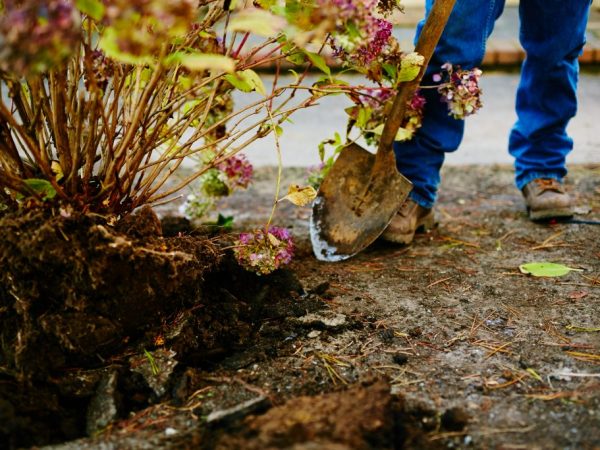
Content
- 1 Why transplant hydrangeas: why you need to do it
- 2 When is it better to transplant hydrangeas: in spring or autumn, is it possible in summer
- 3 How to transplant hydrangeas to another place: rules for choosing and preparing a planting pit
- 4 Transplanting hydrangeas to a new place: step by step instructions
- 5 Hydrangea care after transplant
Why transplant hydrangeas: why you need to do it
Time passes (5-10 years), the hydrangea grows, it ceases to have enough space (light) and nutrition, the flowers become smaller, the shrub ceases to please the eye. What to do, how to return it to its former charm?
Of course, there are other reasons for a hydrangea transplant. For example, you urgently need to free up space for a building or you decide to create a beautiful composition in another place.
And even more often the hydrangea has to be transplanted due to the fact that in this place it simply does not grow and does not bloom, because it turned out to be inappropriate or you initially made a wrong landing.
Alternatively, you can propagate hydrangea one of the vegetative ways, for example, cut.
Video: propagation of hydrangea by cuttings
Or dig young shoots of hydrangea into the groove (hole), in other words, propagate hydrangea by layering.
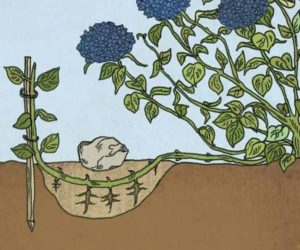
However, there is another, easier way to rejuvenate your flowering shrub in a way, namely, its division and / or transplantation (along with a lump of earth, if you don’t divide it) to another place where all conditions for lush flowering will be created for the hydrangea. Actually, in the case of reproduction by layering, you will also have to plant (transplant) the bush.
Important! Almost all perennial plants (flowers) and especially shrubs (including berry ones) need to be transplanted to new places from time to time.
The site also has several detailed materials:
When is it better to transplant hydrangeas: in spring or autumn, is it possible in summer
Some gardeners believe that hydrangeas can perfectly tolerate a transplant at any time.
However, it is believed that it is advisable to transplant and even more dividing shrubs in the spring, and not in the fall, because it is always difficult to predict when winter (frosts) will come, and over the summer and autumn the shrub will definitely take root.
Important! Moreover, it is not recommended to transplant large-leaved hydrangea in autumn, because it may simply not have time to take root before frost, because this shrub is not the most frost-resistant and necessarily requires solid shelter for the winter.
Of course, if you are a resident of warm southern regions, then this does not apply to you.
As for whether when to transplant hydrangeas in spring, then it is better to do it,while the bush is sleeping (the buds are not swollen), in other words, in the early spring period, but already at positive temperatures andnaturally after how the snow will melt and melt... So, in the Central lane (Moscow region), you can carry out the procedure already in April-early May.
It is very undesirable to transplant a shrub that has blossomed buds, or even more so when it is already blooming (i.e. in summer). This will definitely negatively affect the duration and quality of survival.
On the other hand, it is in the fall, as a rule, that most flower growers are transplanting hydrangeas to another place.
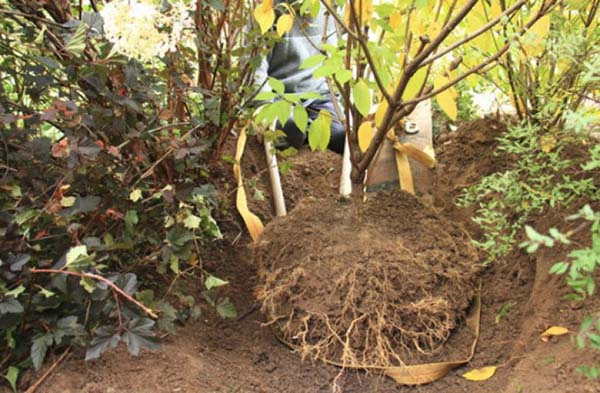
As for the approximate dates, in the Middle Lane (Moscow region), hydrangeas are transplanted in late summer (August) - early autumn (September), in the South of Russia, a transplant can be carried out even in October.
Video: transplanting hydrangeas in autumn
How to transplant hydrangeas to another place: rules for choosing and preparing a planting pit
So, you decide on the time, but before moving on to the most important thing - transplanting hydrangea, you need to choose a good place for planting and choose a suitable soil mixture so that the shrub quickly and well takes root in a new place.
Place in the garden
Finding a site for growing hydrangeas is not so easy. It is optimal to find a place where in the morning or in the evening, the flower rejoiced in the sunand most of the timerested in light shade (especially at lunchtime).
By the way! Despite the fact that it is believed that hydrangea is a shade plant, it will bloom profusely only in a relatively bright place (especially paniculate).

However, the varieties of hydrangeas have their own preferences.
So, paniculate it is better to plant a hydrangea in light shade, in a place that is too sunny, it will fade faster.In addition, the plant is very demanding for watering, and in the bright sun it will be difficult to maintain constant humidity (you will have to water it quite often).
Important! If you have a very hot climate with a scorching sun, then, of course, it is impossible to plant a hydrangea in an open place; it is better to find a place at least in partial shade.
And here large-leaved hydrangea - presentplant shadow, it is quite possible to plant it in partial shade.
It is also very important to choose a place well protected from the winds, otherwise, the eastern or northern hurricanes will simply break all your flowers.
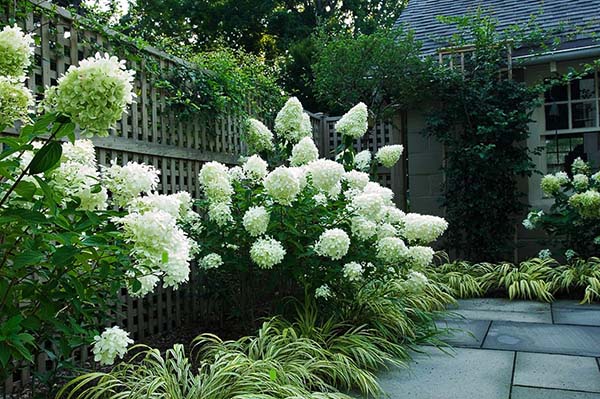
Optimally find a place near the fence or drop off in the background alpine slide.

When choosing a specific place in a summer cottage, you should take into account that you need to plant a shrub near garden paths at some distance (preferably about 1 meter from them), otherwise the spreading branches of a bush during their abundant flowering will close your path and have to tie them up.
Plantunder the trees also does not stand, otherwise the plants will lack nutrient moisture and they will begin to compete for it among themselves.
If you do not want the hydrangea to grow alone, then it will be beautiful to plant it nearby or nearby with garden jasmine (chubushnik), spirea or lilac.
Landing pit
The soil for planting hydrangeas requires loose and fertile soil.
And the most important thing is that hydrangea will grow well only on slightly acidic soils (5-6.2 pH).
Of course, it is advisable to make the landing hole itself in advance, at least a couple of weeks before the day "X" (and preferably a month or a season before).
To make a suitable slightly acidic substrate, you need to prepare a potting potting mix based on sour high (brown) peat. Also work well sawdust of coniferous trees, coniferous litter (forest land) or pine bark (but it is better to use it as mulch). In addition, compost or humus from organic fertilizers can be added to the mixture, from mineral fertilizers - superphosphate (30-40 grams) and potassium sulfate (20-30 grams), from nitrogen - ideally ammonium sulfate (15-20 grams) or 15-20 grams urea or ammonium nitrate (but only for spring planting!). Do not forget to mix everything thoroughly with the earth.
The top garden fertile soil (20 cm), which you have left after digging the hole, is also suitable for adding to the hole. This makes the hydrangea easier to adapt (familiar soil).
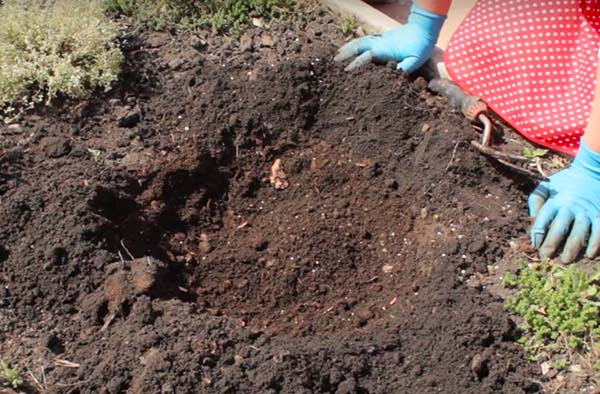
Important! In no case in the substratecan't add dolomite flour, lime or wood ash, sincethese are deoxidizers, but we need, on the contrary, acidifiers.
The size of the planting pit depends on the size of the seedlings themselves, as a rule, it is 50-60 cm in depth and 50-60 cm in width.
If you plan to plant several plants, then plant at a distance of at least 1-1.5 meters, because the bushes, as you already understood, grow quite strongly.
In principle, a hydrangea transplant, namely the preparation of a planting pit, differs little from an ordinary hydrangea planting, except that in this case you have a seedling with a closed root system.
By the way! The site has articles aboutspringand autumn planting.
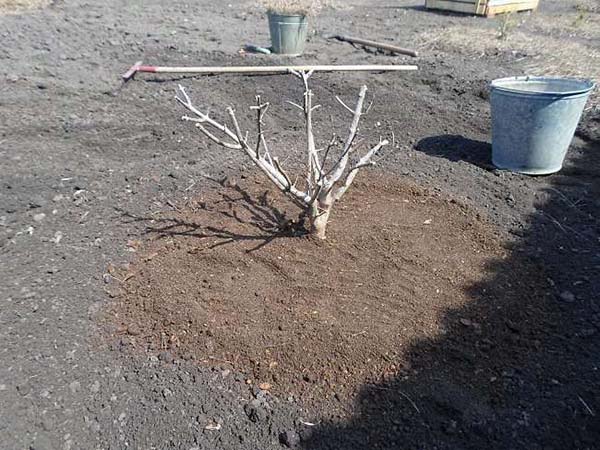
Transplanting hydrangeas to a new place: step by step instructions
Note! When replanting almost all shrubs, they should be at least slightly trimmed (pruned) in order to equalize the aboveground and underground parts. The plant must be shortened, since the injured root system may simply not be able to cope with the direction of nutrition to the remaining branches, especially during the hot period of summer.
Digging and transplanting together with an earthen clod
Step-by-step instructions for transplanting hydrangea to another place:
Important! It is given on the example of paniculate hydrangea, but there are no special differences in planting a tree or large-leaved one.
- Find a new (suitable) place in the garden.
- Dig a planting hole in advance and add the necessary nutritious and acidic substrate to it.
Important! You do not need to make any mounds, they will only be required if you are planting a seedling with an open root system (in order to conveniently spread the roots). In your case, you are replanting with a clod of earth, i.e. with a closed root system.
- Before digging up the hydrangeas, it is recommended to spill the bushes well with water so that the earthen lump holds tight and does not fall apart during transplantation.
- Next, you need to carefully dig it (bush) from all sides (along the perimeter), stepping back from the center by 20-25 centimeters.
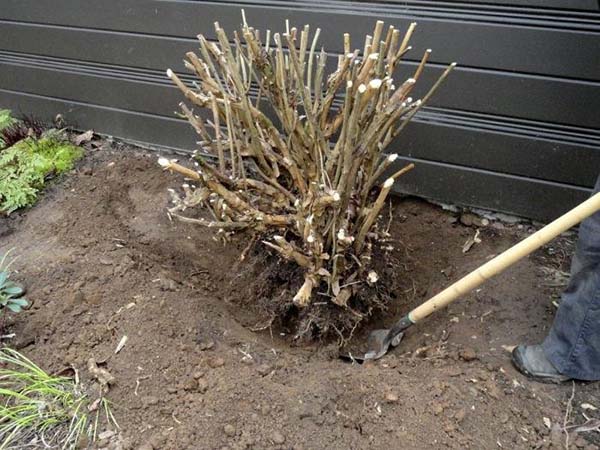
- If possible, you need to keep the earthen lump intact as much as possible.
- Place the seedling with a clod of earth in the center of the planting hole.
- Fill with soil to the root collar so that it is at the level of the soil (if you deepen it too deeply, it may begin to rot) and lightly tamp (press with your hands).
- Water again abundantly.
- If the earth settles, then you will definitely need to fill up.
In general, the procedure for watering and adding soil is best done at least a couple of times. This will help get rid of the air between the roots and the ground.
- In conclusion, it is imperative to mulch (with high peat, bark of coniferous plants or coniferous litter) with a layer of 5-8 centimeters.
Hydrangea loves moisture very much, mulch is a great way to retain moisture. This is all the more necessary if you planted it in a sufficiently sunny area.
- Shade a little (for example, putting a frame on the sunny side and pulling gauze or spunbond) for a couple of weeks.
Transplant with dividing bushes
In general, everything is the same except for a few nuances and the direct division procedure:
- After digging, you must clean the root system of the shrub from excess soil so that it is convenient to divide it.
- Next, the bush is divided (cut with a knife or ax) into several parts, each with renewal buds.
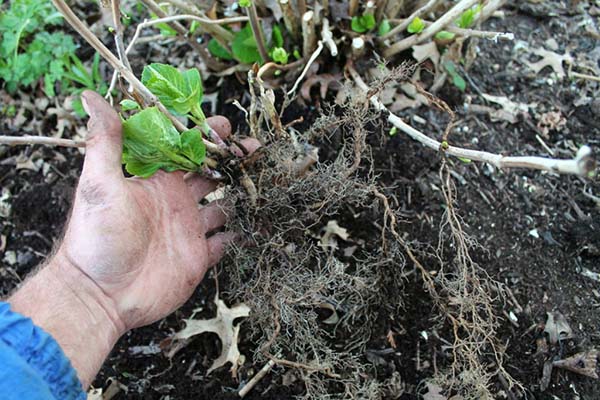
- Now, each bush-cut, like seedlings with an open root system, must be planted on mounds, on which it will be convenient to spread their roots.
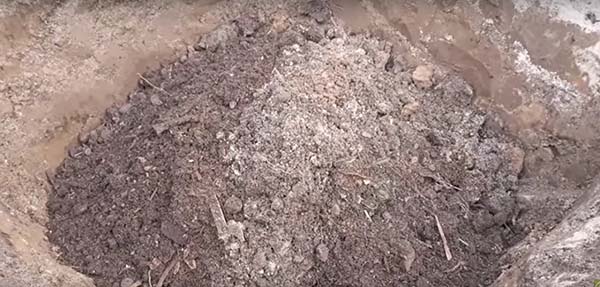
- Cover with nutritious soil and water - everything is similar to a conventional transplant.
Hydrangea care after transplant
In the first year after transplantation (especially in the case of division), it is very important to monitor the soil moisture. Watering should be regular, and in the first month it is advisable to carry it out with the addition of stimulants of growth and root formation, such as Epin or Heteroauxin.
Advice! In the year after the spring transplant, do not let the hydrangea bloom (cut off the flower stalks). Let her spend all her energy on growing roots, and not on flowering.

Indeed, hydrangea loves well-moisturized soil. This is the flower that drinks a lot of water and always drinks.
But everything should be in moderation, the shrub also does not like overflow.
Also, do not forget to periodically loosen and weed the weed circle around the trunk.
In the near future, no additional fertilizing will be required for hydrangeas, but only if you have laid in a sufficient amount of fertilizer when preparing the nutrient soil to fill the planting pit.
By the way! The site already has a detailed article about how and what to fertilize hydrangeas in spring and summer.
If in the future you want to change the color of your hydrangeas - make blue from pink or vice versa, then you will need to adjust the acidity of the soil. This can be done with the help of special fertilizers and chemical compositions, as described in detail. in this material.
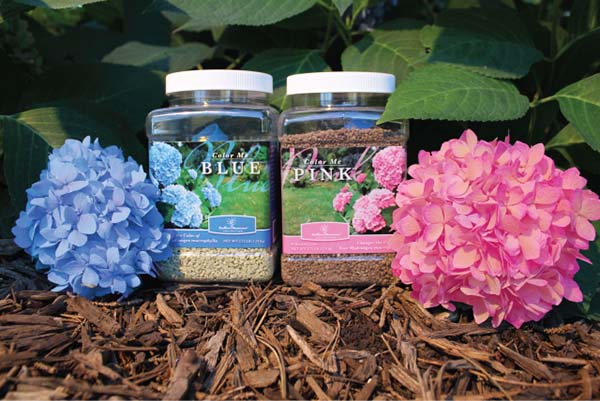
Hydrangea can prune both in autumn and spring. Moreover, even if you carried out autumn pruning (it is considered the main and most desirable), then in spring or summer (just before flowering), you should additionally cut out all thin shoots (less than 1 cm thick).
Note! Full information about spring pruning hydrangea you'll find here, and autumn -here.
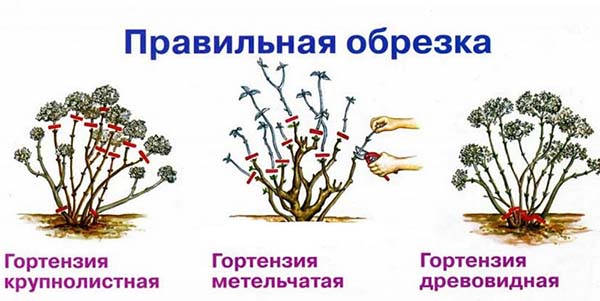
Depending on the type of shrub, its preparation for winter is also different. So, large-leaved hydrangea is not a frost-hardy shrub at all, therefore shelter him just necessary.
Important! In details about autumn care and preparation of hydrangeas for winter readin this article.
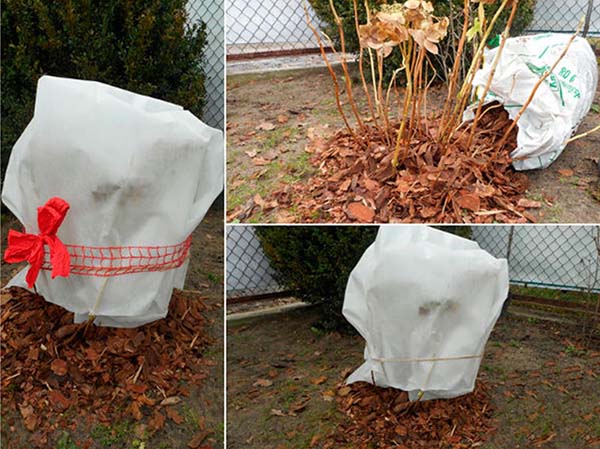
Why does hydrangea not bloom
Advice! The site hasa detailed article about the main reasons why hydrangea may not bloom.
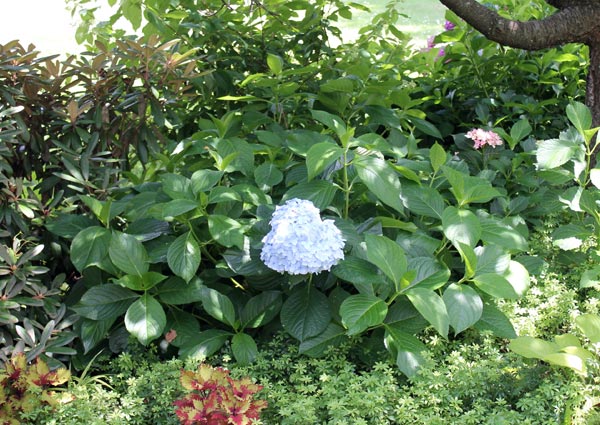
Thus, replanting the hydrangea to another location is a boon for your shrub. The main thing is to carry out the procedure according to all the rules, including not forgetting to carefully look after it. And at what time: in spring or autumn, it's up to you to decide. In principle, both are acceptable.
Video: hydrangea transplant


Wonderful!!! A clear, concrete guide to action! Thank you for the information and positive emotions.
Excellent recommendations, all the subtleties are reflected. Good luck to you!
The information is clearly presented, thanks 🙌 I emphasize a lot for myself and put it on the shelves in my head ... I'm a teapot in gardening! But, with the purchase of my house with a plot, I want to make a cozy garden in the future!
It is very pleasant to hear such kind words! 🙂
Hello Nadezhda! Now in the suburbs of Moscow, autumn is very warm. Is it possible to transplant a large-leaved hydrangea with a bush division in the near future?
Good day, Svetlana!
It is believed that autumn is not the best time for division (especially large-leaved ones), but since the weather is favorable, then why not. Just do not forget to make a solid shelter for the winter (otherwise it can easily freeze out).